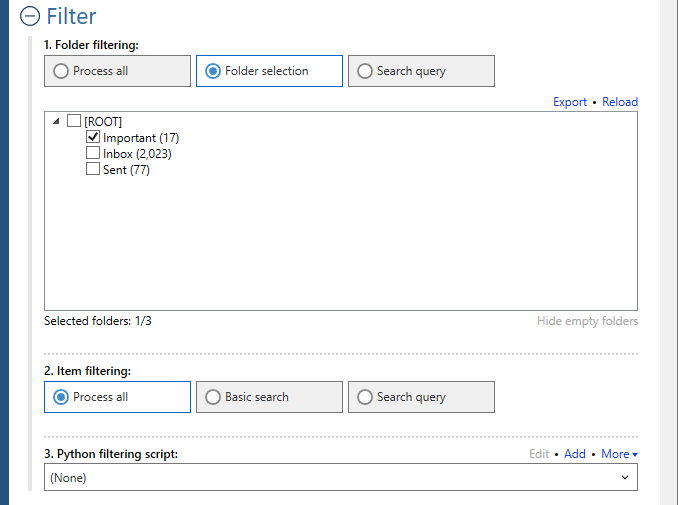Welcome to Fookes Software’s support portal
How to combine multiple PST files (with or without Outlook)
Aid4Mail makes it easy to combine multiple PST files. Compared to competing tools:
- Aid4Mail is faster.
- More accurate with no data loss.
- Offers more control over the conversion process.
Many tools claim to combine Outlook PST files but be aware of lost metadata, folder hierarchy and status information. Aid4Mail is the best tool on the market for combining PST files.
This article will show you how to combine Microsoft Outlook PST files using Aid4Mail. We have been developing Aid4Mail for over 20+ years and have lots of experience working with the Outlook PST file type.
If you don’t yet have a copy of Aid4Mail, you can use our free trial version to test it out or purchase a low-cost 1-month Aid4Mail Converter license.
Please follow the steps below. For any setting that’s not specifically mentioned, you can either use the default (preset) value or consult the Aid4Mail User Guide for details.
Step 1: Open Aid4Mail’s settings
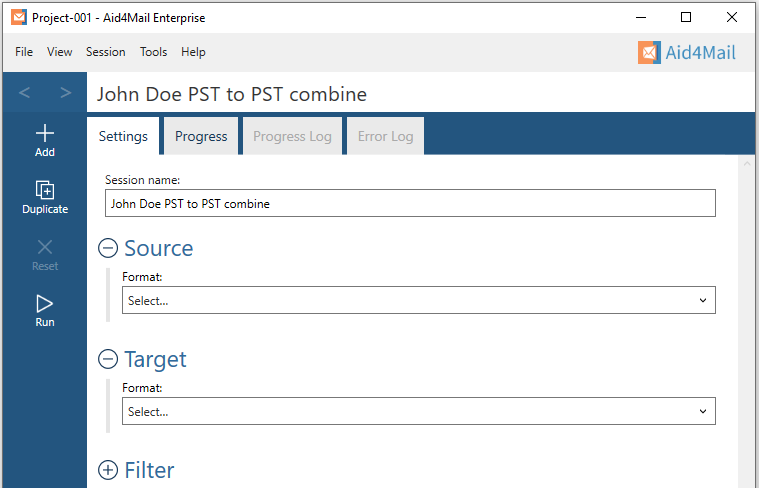
- In Aid4Mail, select the Settings tab.
- Update the Session name to so it describes for the task at hand. In this example, we will be combining John Doe’s PST files to a single PST file so we’ve entered John Doe PST to PST combine as the session name.
- Below the session name there are three sections: Source, Target and Filter. Each can be displayed or hidden by selecting the +/- symbol next to the section heading. This tutorial requires them all to be displayed.
Step 2: Set PST as your source
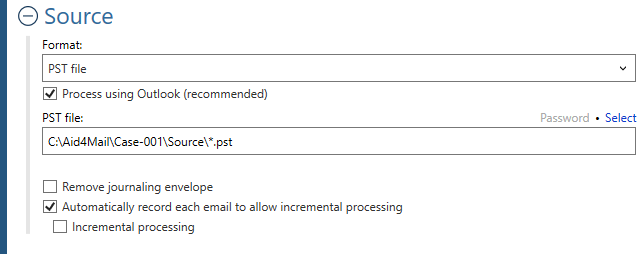
- In the Format list, select PST.
- Choose whether to Process using Outlook. This means using Outlook’s internal engine (MAPI) to open and read the PST file. Using Outlook’s engine is faster but requires Outlook to be installed on the same computer as Aid4Mail. If you don’t have Outlook installed, turn this option off.
- Set the Location of your PST files, either writing it directly in the PST file: field or by using the Select button to browse your file system. Once you have entered the folder where your PST files are located, you will need to enter the asterisk wildcard as shown in the screenshot above. This will allow you to create a session for each PST file in the location you have set (Step 4 explains how to accomplish this).
- Choose whether to Remove journaling envelope if your email files are journaled.
Step 3: Set PST file as your target
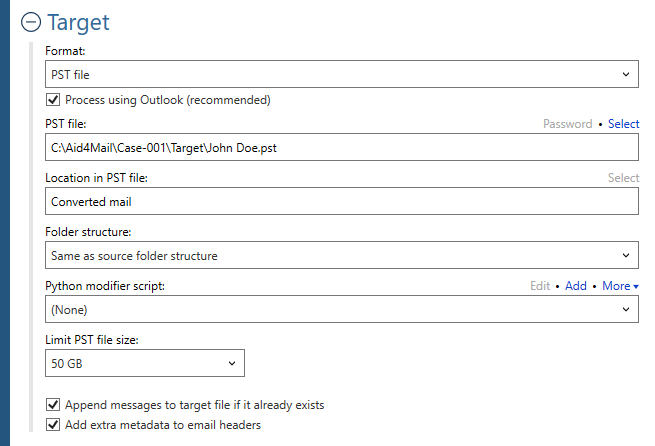
- In the Format list, select PST file.
- Choose whether to Process using Outlook. This means using Outlook’s internal engine (MAPI) to create the PST file (it has no effect on the reading of your source mail). Using Outlook’s engine is faster but requires Outlook to be installed on the same computer as Aid4Mail. If you don’t have Outlook installed, keep this option off.
- Specify where you want your PST file to be saved. You can write directly in the field or use the Select button to browse your file system. You can also set a Password to protect the file.
- Optionally, set a folder Location in PST file where your converted mail will be saved. In our example, we have set a folder called Converted mail. This folder doesn’t exist yet but Aid4Mail will create it.
- Select an option for the Folder structure of the exported mail. Usually you’ll want to keep it the same as the original, so choose Same as source folder structure.
- Decide whether to Limit PST file size. In our example, we’ve set it to 50GB which is the maximum file size allowed by Outlook by default. Once the file has reached its limit, subsequent emails will overflow into a second PST file. And once that one’s full, then into a third, and so on.
- Check or turn-on the option Append messages to target file if it already exists.
- Add extra metadata to email headers when your chosen target format or settings would otherwise result in data loss. For example, if the target format doesn’t support some of the source format’s header fields. Or if the original folder structure would be lost due to your settings. With this option, the data is not lost but instead added to the email headers.
Step 4: Duplicate the Session and update Settings
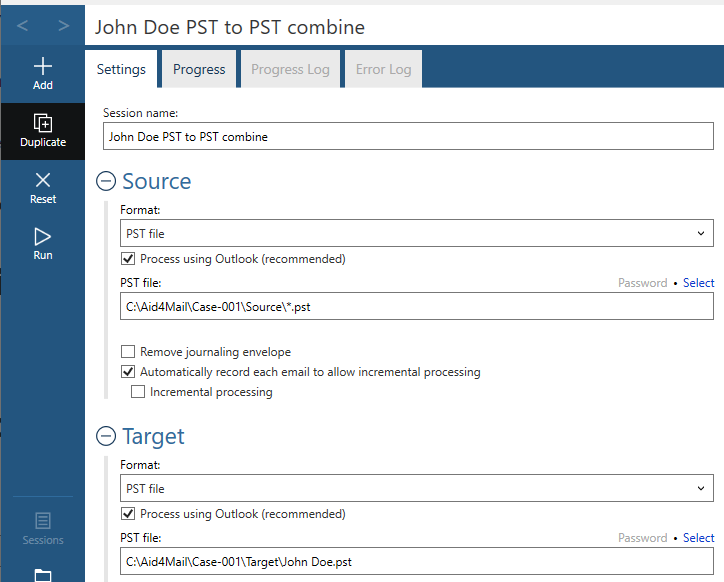
- Once you have completed Steps 1-3, you can now click on the Duplicate button.
- Aid4Mail will now create a new session for each PST File in the source PST File: location. In our example, Aid4Mail will create a new session for each PST file in the following location: C:\Aid4Mail\Case-001\Source\. You can show all of the sessions that Aid4Mail created by clicking on Show session list button.

- Lastly, you will need to click on App (bottom left-hand side of Aid4Mail) and then navigate to the Sessions tab. Now you need to update the option Maximum sessions running concurrently: to 1. You can now exit out of the App Settings using the X on the top right-hand side.
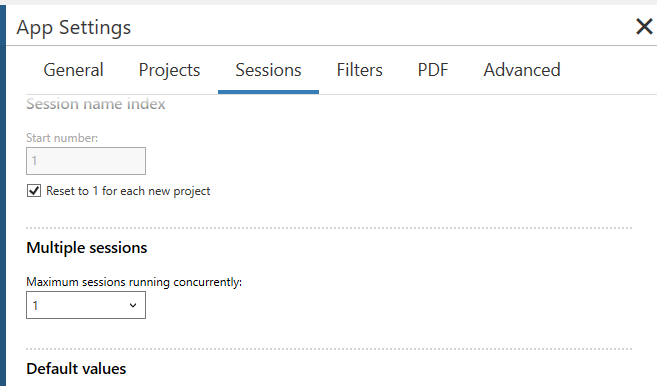
Step 5: Set your filter (optional)
- Under Folder filtering, pick Folder selection.
- Select the folders you want Aid4Mail to process for each PST file. The others will be skipped.
Step 5: Run your Sessions
Select the Run button or Session > Run from the menu if you are using the Converter license for each session. If you have the Investigator or Enterprise license, you can select the Run All button. Aid4Mail will now combine your chosen PST files to the single PST file. Aid4Mail will complete each session one after another. It will automatically open the Progress tab in each session so you can monitor what’s going on. Once finished, you will find full reports in the Progress log and, if relevant, the Error log.
Step 6: Open the PST file in Outlook
You can do this by selecting File > Open > Outlook Data File from Outlook’s main menu (older versions of Outlook may use different menu names).
That’s it!
We hope you found this tutorial helpful in showing you why Aid4Mail is the best tool for combining PST files on the market. If you also need to remove duplicates from the PST files, the Aid4Mail Investigator or Enterprise licenses would allow you to combine PST files without duplicates. If you have any questions on how to combine Outlook PST files, get in touch with us.
If you’re looking for further information, first take a look through the Aid4Mail user guide and our knowledge base articles.
If you still have questions, don’t hesitate to contact our award-winning Helpdesk.
If you’d like to buy an Aid4Mail license, please visit the online store.
Or if you’d like to try Aid4Mail first before purchasing, download a free trial and combine PST files today. We want you to have full confidence in Aid4Mail!
